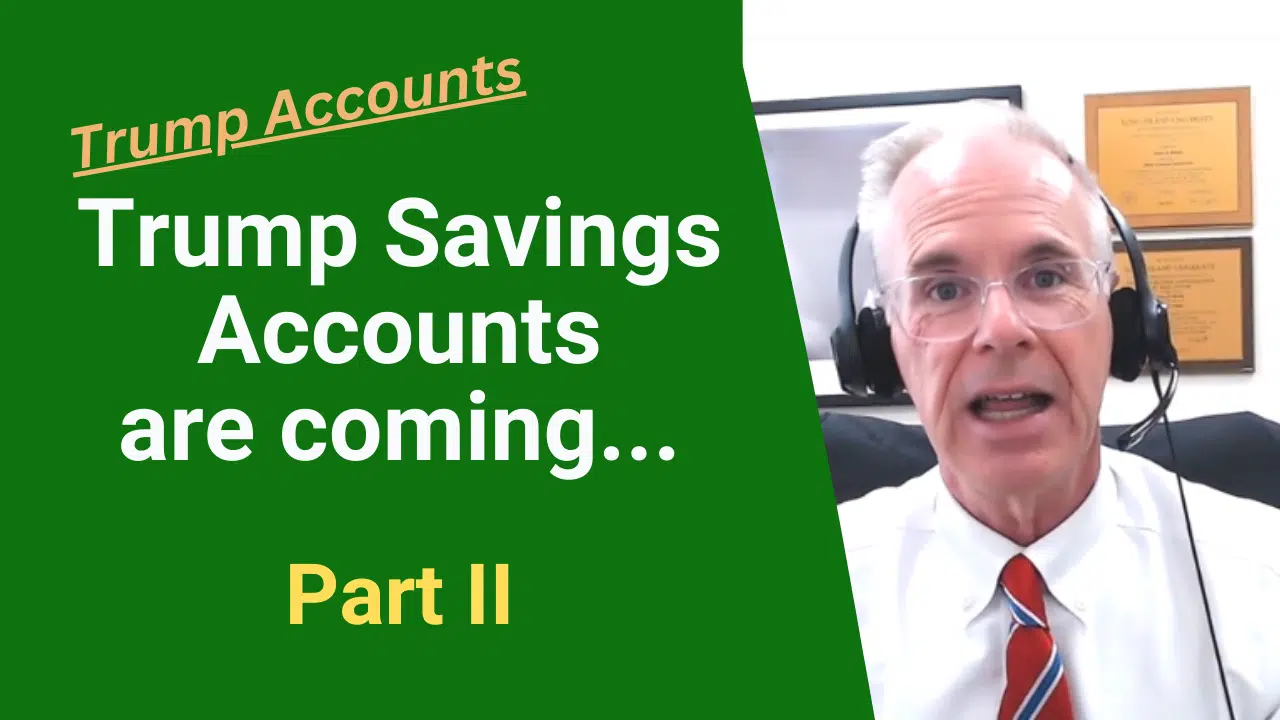Trump Savings Account
Key take-aways:
- No tax deduction for contributions
- Cash only (no appreciated stock deposits)
- Contributions: before age 18: only parents, guardians, or employers can contribute (up to $5,000/year)
- Contributions: after 18 ? only the account owner can contribute, with earned income (like an IRA)
- Withdrawals before 59½ = taxable income and 10% penalty, unless for college or a first-time home purchase
- Works almost exactly like an IRA — long-term, retirement-focused savings for young people
Trump Savings Account – Links
Catch all our Mullooly Asset videos here
Subscribe to the Mullooly Asset YouTube Channel
Watch this episode (“The Trump Savings Account Part II”) on our YouTube Channel
Watch Part I “Trump Accounts Are Coming” here
Link to Morningstar Article: 10 Things to Know About the Trump Savings Account
Trump Savings Account – Transcript
We had a few more additions that we wanted to make, talking about Trump savings accounts.
We had a few more questions as well. So let’s dig right into it.
Do you get a tax deduction for contributions made to a Trump savings account? No.
Next question. Can you contribute shares of an appreciated stock to a Trump savings account? No.
This works a lot like an IRA. And you’re going to hear that phrase a lot in this video.
When you’re putting money into an IRA, it’s cash only.
You’ve got to deposit funds… not appreciated stock.
It works the same way with a Trump savings account.
Here’s a good way to think about this:
Prior to age 18, the only people who can put money in to a Trump savings account are the parents, guardians, you know, other adults. The adults can put money in, as I mentioned in the first video.
Employers can put contributions in. That all counts towards the annual cap of $5,000.
You can think of these essentially as gifts to a minor.
Think of it as someone else is putting money into this account. It’s a gift.
But what happens when the account owner turns 18 and beyond?
The ONLY person who can put money into a Trump savings account at that point – after age 18, is the account owner.
And to do that, the account owner needs to have earned income. Just like an IRA.
So, beyond the age of 18, this account, this Trump savings account, starts to look, act, and feel like an IRA.
Let’s talk about distributions from Trump savings accounts.
Prior to age 18, the answer is effectively, no. You can’t take money out of these accounts. It’s very difficult to do.
There are a couple of technicalities where you could move money out of an account.
One example is if you’re transferring it from “Bank A” to “Bank B” or “Broker C.”
But it has to be a going to another Trump savings account for the benefit of the very same person. That’s just a transfer.
You could also move money that’s in a Trump savings account into an ABLE account.
That’s an account that can be set up if a child is disabled.
And yes, you can withdraw the money if the child passes away.
Hopefully that never happens.
What about distributions BEYOND the age of 18?
Remember, this is like taking money from an IRA. So the first thing that parents need to be reminded of is “it is their money.”
They can pretty much do what they want with it, but it does come with strings.
If you take money out of a Trump savings account, just like an IRA, prior to age 59 and a half… there is going to be a 10% penalty on that. Plus it’s also going to be taxable income to them.
Now, there’s no way of knowing what tax bracket an 18, 19, 20-year-old person is going to be in.
But just know that this is going to show up as taxable income and there will be a 10% penalty.
Now, what if you’re taking the money out to use for college?
Well, in that case, there is no 10% penalty. It’s just like an IRA – no 10% penalty. It is going to be considered taxable income.
What if you’re taking money out of a Trump savings account for the, uh, if you’re a first time home buyer?
Well, you can only – just like an IRA – you can only withdraw up to $10,000.
So there’s a cap on that.
Plus, while there’s no 10% penalty, it IS going to be considered taxable income to you as well.
After turning 18, the regular IRA rules apply, in most cases.
So you’re going to have limitations on rollovers.
You’re going to have limitations on transfers.
And yes, there’s going to someday be required minimum distributions!
We are talking a long time from.
Now, I don’t mean to sound like a Debbie Downer, but there have been people who have been referring to these accounts as a way to save additional money for college. Or a way to put money aside for the purchase of a home at some point.
Understand that this account is designed to be a long-term savings, a long-term growth vehicle, for young people. It’s going to be a retirement account for young people.
But I’ll also add that rules change, and things change, over time.
IRAs were first created 50 years ago in 1975.
When they wrote the rules, practically no one qualified.
No one was able to put any money into these things.
It wasn’t until the Economic Recovery Tax Act, it’s called ERTA, in 1981… 6 years later… that they expanded IRAs for pretty much everybody.
And that’s silly “10% penalty prior to age 59 and a half…”?
That didn’t even exist when they created IRAs in 1975, and even when they expanded them again in 1981.
That didn’t happen until the Tax Reform Act in 1986.
The point is that things can change over time.
These are how these Trump savings accounts are structured right now.
I have absolutely no doubt that putting money away for a young child and letting it compound for 40, 50, 60 years is going to really, really help some people out.








